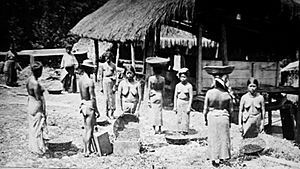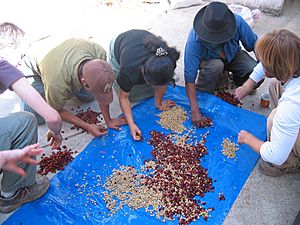Coffee production in Guatemala facts for kids
Coffee production in Guatemala is a big part of the country's economy. Guatemala has been a major producer of coffee for a long time. For most of the 1900s and early 2000s, it was the top coffee producer in Central America. However, in 2011, Honduras started producing more coffee.
Contents
Where Coffee Grows Best in Guatemala
Coffee plants need special conditions to grow well and produce lots of beans. The best temperature for coffee in Guatemala is between 60 and 90 degrees Fahrenheit (about 15 to 32 degrees Celsius).
Altitude and Shade for Coffee Plants
- In lower areas, around 500 to 700 meters (about 1,600 to 2,300 feet) above sea level, young coffee plants need shade to protect them from the sun.
- In higher places, like 1,500 meters (about 4,900 feet) up, coffee farms need protection from cold northern winds.
- Most coffee farms in Guatemala are located at altitudes from 500 to 5,000 meters (about 1,600 to 16,400 feet) above sea level.
A Brief History of Coffee in Guatemala
Coffee farming started to grow in Guatemala in the 1850s and 1860s. At first, farmers grew coffee alongside a red dye called cochineal. German immigrants played a very important role in bringing coffee farming to the country.
Early Coffee Farms and Growth
Small coffee farms began in areas like Amatitlán and Antigua. However, it was slow to start because people didn't know much about growing coffee and lacked the right tools. Many farmers needed loans to pay for their coffee estates, called fincas. Over time, foreign companies often bought these farms because they had more money to invest.
Coffee Production Increases
A big challenge was finding enough workers to help grow and harvest the coffee. Despite this, coffee production grew a lot:
- In 1887, Guatemala produced over 48.5 million pounds (about 22 million kilograms) of coffee.
- By 1891, this increased to over 52 million pounds (about 23.6 million kilograms).
- Between 1879 and 1883, Guatemala exported more than 293 million pounds (about 133 million kilograms) of coffee.
- By 1902, the most important coffee farms were found along the southern coast.
Main Coffee Growing Regions
Many areas in Guatemala were perfect for growing coffee, and the types grown in warmer regions were especially good. Coffee was grown around Guatemala City, Chimaltenango, and Verapaz. Most coffee farms were located in departments like Guatemala, Amatitlan, Sacatepequez, Solola, Retalhuleu, Quezaltenango, San Marcos, and Alta Verapaz.
Anacafé: Supporting Guatemalan Coffee
Anacafé, which stands for Asociación Nacional del Café, was created in 1960. It is a national association that represents all coffee farmers in Guatemala. It was started to help collect information about the country's coffee production.
Guatemalan Coffee Regions
Anacafé has created a special brand called "Guatemalan Coffees." They have identified eight unique coffee regions, using the slogan "A Rainbow of Choices." These regions are:
- Acatenango Valley
- Antigua Coffee
- Traditional Atitlan
- Rainforest Coban
- Fraijanes Plateau
- Highland Huehue
- New Oriente
- Volcanic San Marcos
Anacafé's Work
Anacafé does many things to support the coffee industry:
- They have built Analab coffee laboratories to test coffee quality.
- They have a program called funcafé that helps children.
- They publish a coffee magazine called El Cafetal.
- Anacafé represents Guatemala at meetings of the International Coffee Organization.
- They get their money from small fees on exported coffee.
See also
 In Spanish: Café de Guatemala para niños
In Spanish: Café de Guatemala para niños




